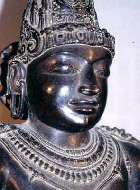Hinduism in Tamil Nadu
| தமிழ்நாடு இந்துக்கள் | ||||||||||
|---|---|---|---|---|---|---|---|---|---|---|
| ||||||||||
| Total population | ||||||||||
|
63,188,168 (2011)[1] 87.58% of the Tamil Nadu Population | ||||||||||
| Languages | ||||||||||
| Tamil | ||||||||||
Hinduism in Tamil Nadu dates back to 5th century BC finding literary mention in Sangam literature. The total number of Tamil Hindus as per 2011 Indian census is 63,188,168[2] which forms 87.58% of the total popualation of Tamil Nadu. Hinduism is the major religion in the South Indian state of Tamil Nadu.
The religious history of Tamil Nadu is influenced by Hinduism quite notably during the medieval century. The twelve Azhwars (saint poets of Vaishnavite tradition) and sixty-three Nayanars (saint poets of Shaivite tradition) are regarded as exponents of the bhakti tradition of Hinduism in South India. Most of them came from the Tamil region and the last of them lived in the 9th century CE.
There are quite some worship forms and practices in Hinduism that are specific to Tamil Nadu. There are lot of Mathas (meaning monastic institutions) and temples based out of Tamil Nadu. In modern times, most of the temples are maintained and administered by the Hindu Religious and Endowment Board of the Government of Tamil Nadu.
History
Prehistory
Tolkappiyam, possibly the most ancient of the extant Sangam works, dated between the 3rd century BCE and 5th century CE glorified Murugan, the favoured god of the Tamils.".[3]
Medieval Period (600–1300)
The Cholas who were very active during the Sangam age were entirely absent during the first few centuries. The period started with the rivalry between the Pandyas and the Pallavas, which in turn caused the revival of the Cholas. The Cholas went on to becoming a great power. Their decline saw the brief resurgence of the Pandyas. This period was also that of the re-invigorated Hinduism during which temple building and religious literature were at their best.[4]

The Cheras ruled in southern India from before the Sangam era (300 BCE – 250 CE) over the Coimbatore, Karur, Salem Districts in present-day Tamil Nadu and present day Kerala from the capital of Vanchi Muthur in the west, (thought to be modern Karur).
The Kalabhras, invaded and displaced the three Tamil kingdoms and ruled between the third and the seventh centuries CE of the Sangam period. This is referred to as the Dark Age in Tamil history and Hinduism in Tamil Nadu. They were expelled by the Pallavas and the Pandyas in sixth century. During Kalabhras' rule Jainism flourished in the land of the Tamils and Hinduism was suppressed. Because the Kalabhras gave protection to Jains and perhaps Buddhists, too, some have concluded that they were anti-Hindu, although this latter view is disputed.
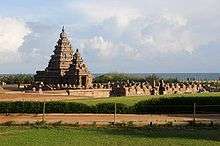
During the forth to eighth centuries century CE, Tamil Nadu saw the rise of the Pallavas under Mahendravarman I and his son Mamalla Narasimhavarman I.[5] Pallavas ruled a large portion of South India with Kanchipuram as their capital. Mahendra Varman was principally a Buddhist, but converted to Hinduism by the influence of Saivite saints. It was under him that Dravidian architecture reached its peak with the Pallava built Hindu temples. Narasimhavarman II built the Shore Temple which is a UNESCO World Heritage Site.
The Pallavas were replaced by the Cholas as the dominant kingdom in the 10th century C.E and they in turn were replaced by Pandyas in the 13th century CE with their capital as Madurai. Temples such as the Meenakshi Amman Temple at Madurai and Nellaiappar Temple at Tirunelveli are the best examples of Pandyan temple architecture.[6]
Chola Empire
By the 9th century CE, during the times of the second Chola monarch Aditya I, his son Parantaka I, Parantaka Chola II itself the Chola empire had expanded into what is now interior Andhra Pradesh and coastal Karnataka, while under the great Rajaraja Chola and his son Rajendra Chola, the Cholas rose as a notable power in south Asia.
The Cholas excelled in building magnificent temples. Brihadeshwara Temple in Thanjavur is a classical example of the magnificent architecture of the Chola kingdom. Brihadshwara temple is an UNESCO Heritage Site under "Great Living Chola Temples."[7] Another example is Annamalaiyar Temple located at the city of Tiruvannamalai and the Chidambaram Temple in the heart of the temple town of Chidambaram. With the decline of the Cholas between 1230 and 1280 CE, the Pandyas rose to prominence once again, under Maravarman Sundara Pandya and his younger brother, the celebrated Jatavarman Sundara Pandyan. This revival was short-lived as the Pandya capital of Madurai itself was sacked by Alauddin Khilji's troops under General Malik Kafur in 1316 CE.[8]
Vijayanagar and Nayak period (1336–1646)
These Muslim invasions triggered the establishment of the Hindu Vijayanagara Empire in the Deccan. It eventually conquered the entire Tamil country (c. 1370 CE). This empire lasted for almost two centuries till the defeat of Vijayanagara in the Battle of Talikota in 1565. Subsequent to this defeat, many incompetent kings succeeded to the throne of Vijayanagara with the result that its grip loosened over its feudatories among whom the Nayaks of Madurai and Tanjore were among the first to declare their independence, despite initially maintaining loose links with the Vijayanagara kingdom."[9] As the Vijayanagara Empire went into decline after mid-16th century, the Nayak governors, who were appointed by the Vijayanagar kingdom to administer various territories of the empire, declared their independence. The Nayaks of Madurai and Nayaks of Thanjavur were most prominent of them all in the 17th century. They reconstructed some of the oldest temples in the country such as the Meenakshi Temple.
Rule of Nawabs, Nizams and British (1692–1947)
In the early 18th century, the eastern parts of Tamil Nadu came under the dominions of the Nizam of Hyderabad and the Nawab of the Carnatic. While Wallajah was supported by the English, Chanda Shahib was supported by the French by the middle of the 18th century. In the late 18th century, the western parts of Tamil Nadu, came under the dominions of Hyder Ali and later Tipu Sultan, particularly with their victory in the Second Anglo-Mysore War. After winning the Polygar wars, the East India Company consolidated most of southern India into the Madras Presidency coterminous with the dominions of Nizam of Hyderabad. Pudukkottai remained as a princely state. The Hindu temples were kept intact during this period and there is no notable destruction recorded.
Tamil Nadu in independent India (1947 -)
When India became independent in 1947, Madras Presidency became Madras State, comprising present day Tamil Nadu, coastal Andhra Pradesh, South Canara district Karnataka, and parts of Kerala. The state was subsequently split up along linguistic lines. In 1969, Madras State was renamed Tamil Nadu, meaning Tamil country.

The total number of Tamil Hindus as per 2011 Indian census is 63,188,168[10] which forms 87.58% of the total popualation of Tamil Nadu.
| Parameter | Population |
|---|---|
| Total Population | 54985079 |
| Literates Population | 35011056 |
| Workers Population | 25241725 |
| Cultivators Population | 4895487 |
| Agricultural Workers Population | 8243512 |
| HH Industry Workers Population | 1330857 |
| Other Workers Population | 10771869 |
| Non-Workers Population | 29743354 |
Saints
The twelve Azhwars (saint poets of Vaishnavite tradition) and sixty-three Nayanmars (saint poets of Shaivite tradition) are regarded as exponents of the bhakti tradition of Hinduism in South India.[12] Most of them came from the Tamil region and the last of them lived in the 9th century CE. Composers of Tevaram - the Tamil saint poets of 7th century namely Appar, Tirugnana Sambandar and Sundarar with the 9th-century poet Manickavasagar, the composer of Tiruvacakam were saints of Shaivism. The saivite saints have revered 276 temples in Tevaram and most of them are in Tamil Nadu on both shores of river Cauvery. Vaippu Sthalangal are a set of 276 places having Shiva temples that were mentioned casually in the songs in Tevaram.[13] The child poet, Tirugnana Sambandar was involved in converting many people from Buddhism and Jainism to Hinduism. The saint Appar was involved in Uzhavatru padai, a cleaning and remodification initiative of dilapidated Shiva temples. The Azhwars, the 12 vaishnavite saint poets of 7th-9th century composed the Divya Prabandha, a literary work praising god Vishnu in 4000 verses.
The development of Hinduism grew up in the temples and mathas of medieval Tamil Nadu with self-conscious rejection of Jain practises.[14]
Monastic institutions
Saivite
Kanchi Matha's official history states that it was founded by Adi Sankara of Kaladi, and its history traces back to the fifth century BCE.[15] A related claim is that Adi Sankara came to Kanchipuram, and that he established the Kanchi mutt named "Dakshina Moolamnaya Sarvagnya Sri Kanchi Kamakoti Peetam" in a position of supremacy (Sarvagnya Peetha) over the other mathas of the subcontinent, before his death there. Other sources give the place of his death as Kedarnath in the Himalayas.[16][17]
Madurai Adheenam is the oldest Saivite Matha in South India established around 600 CE by saint Campantar. It is located two blocks from the huge Madurai Meenakshi Amman Temple, one of the most famous Siva-Shakthi shrines in the world. It is an active centre of Saiva Siddantha philosophy. It is currently headed by Sri Arunagirinatha Gnanasambantha Desika Paramacharya.[18] The adheenam is the hereditary trustee of four temples in Thanjavur District.
Thiruvaduthurai Adheenam is a mutt based in the town of Thiruvaduthurai in Kuthalam taluk of Nagapattinam District, Tamil Nadu, India.[19] As of 1987, there were a total of 15 Shiva temples under the control of the adheenam.[20]
Dharmapuram Adheenam is a mutt based in the town of Mayiladuthurai, India. As of 1987, there were a total of 27 Shiva temples under the control of the adheenam.[20]
Vaishnavite Matha
Parakala Mutt was the first monastery of the Sri Vaishnava sect of Brahmin Hindu society. The Mutt was first established by Brahmatantra Swatantra Jeeyar, a disciple of SriVedanta Desika by 1268 A.D. The Mutt got the name "Parakala" by the grace of Tirumangai Alvar also known as Parakalan. The head of this Matha is the heredetary Acharya of the Mysore Royal Family. The Hayagriva idol worshipped here is said to be handed down from Vedanta Desika.[21]
Ahobila Mutt (also called Ahobila Matam) is a Vadakalai Sri Vaishnava religious institution established 600 years ago at Ahobilam in India by Athivan Satakopa Svami (originally known as Srinivasacharya).[22][23][24] Athivan Sathakopa, a Vadakalai Brahmin,[25] who was a great grand disciple of Vedanta Desika[26][27] and a sishya of Brahmatantra Swatantra Jiyar of Parakala Mutt,[28] founded and established the Muth, based on the Pancharatra tradition.[29][30][31][32] Since then a succession of forty-six ascetics known as "Azhagiya Singar" have headed the monastic order.
Worship forms
Hinduism is a diverse system of thought with beliefs spanning monotheism, polytheism, panentheism, pantheism, monism, atheism, agnosticism, gnosticism among others;[33][34][35][36] and its concept of God is complex and depends upon each individual and the tradition and philosophy followed. It is sometimes referred to as henotheistic (i.e., involving devotion to a single god while accepting the existence of others), but any such term is an overgeneralization.[37]
The major worship forms of Shiva temples are for Shiva, Parvathi, Ganesha and Muruga. Vishnu is either worshipped directly or in the form of his ten avatara, most famous of whom are Rama and Krishna.[38]
Lingam
The Lingam (Sanskrit लिङ्गं liṅgaṃ, meaning "mark" or "sign") is a representation of the Hindu deity Shiva used for worship in Hindu temple.[39] The lingam is the principal deity in most Shiva temples in South India. The propagation of linga worship on a large scale in South India is believed to be from Chola times (late 7th century A.D.), through Rig veda, the oldest literature details about worshipping Shiva in the form of linga.[40] Pallavas propagated Somaskanda as the principal form of worship, slightly deviating from the Shaiva agamas; Cholas being strict shaivas, established lingams in all the temples.[41]
Ganesha

Ganesha (Sanskrit: गणेश; IAST: Gaṇeśa; ![]() listen ), also spelled Ganesa or Ganesh, also known as Ganapati (Sanskrit: गणपति, IAST: gaṇapati), Vinayaka (Sanskrit: विनायक; IAST: Vināyaka), and Pillaiyar (Tamil: பிள்ளையார்), is one of the deities best-known and most widely worshipped in the Hindu pantheon.[42] Ganesa is the first son of Shiva and is given the primary importance in all Shiva temples with all worship starting from him. Local legend states the Tamil word Pillayar splits into Pillai and yaar meaning who is this son, but scholars believe it is derived from the Sankrit word pulisara meaning elephant.[43] K. A. Nilakanta Sastri (1963:57-58) thinks that Pallavas adopted the Ganesa motif from Chalukyas.[44] During 7th century, Vatapi Ganapati idol was brought from Badami (Vatapi - Chalukya capital) by
Paranjothi, the general of Pallavas who defeated Chalukyas.[45] In modern times, there are separate temples for Ganesha in Tamil Nadu.
listen ), also spelled Ganesa or Ganesh, also known as Ganapati (Sanskrit: गणपति, IAST: gaṇapati), Vinayaka (Sanskrit: विनायक; IAST: Vināyaka), and Pillaiyar (Tamil: பிள்ளையார்), is one of the deities best-known and most widely worshipped in the Hindu pantheon.[42] Ganesa is the first son of Shiva and is given the primary importance in all Shiva temples with all worship starting from him. Local legend states the Tamil word Pillayar splits into Pillai and yaar meaning who is this son, but scholars believe it is derived from the Sankrit word pulisara meaning elephant.[43] K. A. Nilakanta Sastri (1963:57-58) thinks that Pallavas adopted the Ganesa motif from Chalukyas.[44] During 7th century, Vatapi Ganapati idol was brought from Badami (Vatapi - Chalukya capital) by
Paranjothi, the general of Pallavas who defeated Chalukyas.[45] In modern times, there are separate temples for Ganesha in Tamil Nadu.
Skanda

Murugan (Tamil: முருகன், Sanskrit:सुब्रह्मण्य, Sanskrit: कार्तिकेय) also called Kartikeya, Skanda and Subrahmanya, is more popular in South India especially among Tamil people famously referred as Thamizh Kadavul (God of Tamils). He is the patron deity of the Tamil land (Tamil Nadu).[46] Tolkappiyam, possibly the most ancient of the extant Sangam works, dated between the 3rd century BCE and 5th century CE glorified Murugan, " the red god seated on the blue peacock, who is ever young and resplendent," and " the favoured god of the Tamils.".[3] The Sangam poetry divided space and Tamil land into five allegorical areas and according to the Tirumurugarruppatai (circa 400-450 A.D.) attributed to the great Sangam poet Nakkiirar, Murugan was the presiding deity of the Kurinci region (hilly area). Tirumurugaruppatai is a deeply devotional poem included in the ten idylls (Pattupattu) of the age of the third Sangam.[47] The cult of Skanda disappeared during the 6th century and was predominantly expanded during late 7th century Pallava period - Somaskanda sculptured panels of the Pallava period stand as a testament.[48]
Lingothbhavar
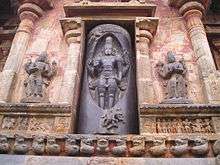
Lingothbhavar or emergence of linga, found in various puranas as a symbol of Shiva, augments the synthesis of the old cults of pillar and phallic worship.[49] The idea emerged from deity residing in a pillar and later visualised as Shiva emerging from the lingam[40] The lingothbhavar image can be found in the first precinct around the sanctum in the wall exactly behind the image of Shiva. Appar, one of the early Saivite saint of the 7th century, gives evidence of this knowledge of puranic episodes relating to Lingothbhavar form of Shiva while Tirugnana Sambandar refers this form of Shiva as the nature of light that could not be comprehended by Brahma and Vishnu.[50]
Nataraja
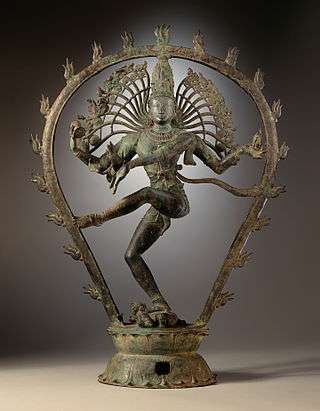
Nataraja or Nataraj, The Lord (or King) of Dance; (Tamil: கூத்தன் (Kooththan)) is a depiction of the Hindu god Shiva as the cosmic dancer Koothan who performs his divine dance to destroy a weary universe and make preparations for god Brahma to start the process of creation. A Tamil concept, Shiva was first depicted as Nataraja in the famous Chola bronzes and sculptures of Chidambaram. The dance of Shiva in Tillai, the traditional name for Chidambaram, forms the motif for all the depictions of Shiva as Nataraja.[51][52][53] The form is present in most Shiva temples in South India, and is the main deity in the famous temple at Chidambaram.[54]
Dakshinamurthy
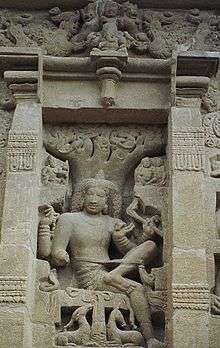
Dakshinamurthy or Jnana Dakshinamurti(Tamil: தட்சிணாமூர்த்தி, IAST:Dakṣiṇāmūrti)[55] is an aspect of Shiva as a guru (teacher) of all fields. This aspect of Shiva is his personification of the ultimate awareness, understanding and knowledge.[56] The image depicts Shiva as a teacher of yoga, music, and wisdom, and giving exposition on the shastras (vedic texts) to his disciples.[57]
Somaskandar
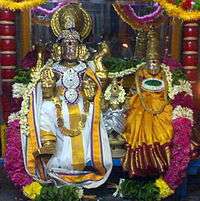
Somaskanda derives from Sa (Shiva) with Uma (Parvathi) and Skanda (child Murugan).[58] It is the form of Shiva where he is accompanied by Skanda the child and Paravati his consort[59] in sitting posture. Though it is a Sanskrit name, it is a Tamil concept and Somaskandas are not found in North Indian temples.[60] In the Tiruvarur Thygarajar Temple, the principal deity is Somaskanda under the name of Thyagaraja.[59] All temples in the Thygaraja cult have images of Somaskandar as Thyagarajar - though iconographically similar, they are iconologically different. Architecturally when there are separate shrines dedicated to the utsava(festival deity) of Somaskanda, they are called Thyagaraja shrines.[61] Unlike Nataraja, which is a Chola development, Somaskanda was prominent even during the Pallava period much earlier to Cholas.[62] References to the evolution of the Somaskanda concept are found from Pallava period from the 7th century A.D. in carved rear stone walls of Pallava temple sanctums.[63] Somaskanda was the principal deity during Pallava period replacing lingam, including the temples at Mahabalipuram, a UNESCO world heritage site. But the cult was not popular and Somaskanda images were relegated to subshrines.[64] Sangam literature does not mention Somaskanda and references in literature are found in the 7th century Tevaram.[63]
Bhairavar
Bhairava is one of the eight forms of Shiva, and translation of the adjectival form as "terrible" or "frightful". Bhairava is known as Vairavar in Tamil where he is often presented as a Grama Devata or folk deity who safeguards the devotee on all eight directions. In Chola times Bhairava is referred as Bikshadanar, a mendicant, and the image can be found in most Chola temples.[65]
Vishnu
Vishnu and his consort Lakshmi are represented in various forms or avatars in Vishnu temples in Tamil Nadu. The most common forms are Rama and Krishna.
Village deities
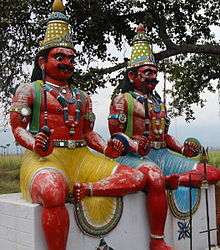
Ayyanar (Tamil: ஐயனார்) is worshipped as a guardian deity predominantly in Tamil Nadu and Tamil villages in Sri Lanka. The earliest reference to Aiynar-Shasta includes two or more hero stones to hunting chiefs from the Arcot district in Tamil Nadu. The hero stones are dated to the 3rd century C.E. It reads "Ayanappa; a shrine to Cattan." This is followed by another inscription in Uraiyur near Tiruchirapalli which is dated to the 4th century C.E.[66] Literary references to Aiyanar-Cattan is found in Silappatikaram, a Tamil Buddhist work dated to the 4th to 5th century C.E.[67] From the Chola period (9th century C.E) onwards the popularity of Aiyanar-Shasta became even more pronounced.[68]
Madurai Veeran (Tamil: மதுரை வீரன், Maturai Vīraņ lit. Warrior of Madurai) is a Tamil folk deity popular in southern Tamil Nadu. His name was derived as a result of his association with the southern city of Madurai as a protector of the city.[69]
Kālī (Tamil: காளி) is the Hindu goddess associated with power, shakti. Kālī is represented as the consort of Shiva, on whose body she is often seen standing. She is associated with many other Hindu goddesses like Durga, Bhadrakali, Sati, Rudrani, Parvati and Chamunda. She is the foremost among the Dasa Mahavidyas, ten fierce Tantric goddesses.[70]
Muneeswarar (Tamil முனீஸ்வரன்) is a Hindu god. 'Muni' means 'saint' and 'iswara' represents 'Shiva'. He is considered as a form of Shiva,although no scriptural references have been found to validate such claims. He is worshiped as a family deity in most Shaivite families.
Karuppu Sami (Tamil: கருப்புசாமி) (also called by many other names) is one of the regional Tamil male deities who is popular among the rural social groups of South India, especially Tamil Nadu and small parts of Kerala. He is one of the 21 associate folk-deities of Ayyanar and is hence one of the so-called Kaval Deivams of the Tamils.
Sudalai Madan or Madan, is a regional Tamil male deity who is popular in South India, particularly Tamil Nadu. He is considered to be the son of Shiva and Parvati. He seems to have originated in some ancestral guardian spirit of the villages or communities in Tamil Nadu, in a similar manner as Ayyanar.
Caste
A steeply classified class structure existed in Tamil Nadu from around 2000 years because of the correlation in the form of cultivation, population and centralization of political system. These classes in turn are grouped into social groups especially in rural areas. The shape of class system in rural Tamil Nadu has changed dramatically because of land reform acts like 'Green Revolution'.[71] As per 2001 census, there was a total of 11,857,504 people in Scheduled castes (SC) constituting 19 percent of Tamil Nadu and 7.1 percent of SC population in India.[72] Leaving 840 in Buddhism and 837 in Sikhism, leaving the remaining 11855827 in Hinduism.[72] The literacy rate (who can read, write and understand) among these stands at 63.2 percent which is lower than the 73.5 state level literacy rate.[72]
Self-Respect Movement
The Self-Respect Movement is a movement with the aim of achieving a society where backward castes have equal human rights,[73] and encouraging backward castes to have self-respect in the context of a caste based society that considered them to be a lower end of the hierarchy.[74] It was founded in 1925 by Periyar E. V. Ramasamy (also known as Periyar) in Tamil Nadu, India. A number of political parties in Tamil Nadu, such as Dravida Munnetra Kazhagam (DMK) and All India Anna Dravida Munnetra Kazhagam (AIADMK) owe their origins to the Self-respect movement,[75] the latter a 1972 breakaway from the DMK. Both parties are populist with a generally social democratic orientation.[76]
Caste based political parties
Caste based political parties were not successful during the 1960s to late 80s when the Indian National Congress, Dravida Munnetra Kazhagam and Anna Dravida Munnetra Kazhagam were dominant. These parties emerged during the late 80s and three of the parties emerged prominent - Pattali Makkal Katchi (Pattali Makkal Katchi) among Vanniyar, Puthiya Tamilakam among Devendrar and Viduthalai Chiruthaigal Katchi among Paraiyar polled 12 percent vote in the 1999 Loksabha elections.[77] After 1931, caste based census was not performed and hence the census data is not available for other castes.[78]
Tamil Calendar
Some of the famous Hindu pilgrimage sites in Tamil Nadu
- Kumbakonam
- Kanchipuram
- Rameswaram
- Madurai
- Tiruchirappalli
- Pudukkottai
Notes
- ↑ "Tamil Nadu Population Census data 2011". Census 2011 - Census of India.
- ↑ "Tamil Nadu Population Census data 2011". Census 2011 - Census of India.
- 1 2 Kanchan Sinha, Kartikeya in Indian art and literature, 1979,Delhi: Sundeep Prakashan.
- ↑ Sastri 1955, p. 387
- ↑ Sastri 1955, pp. 91-92
- ↑ V.K. 2003, pp. 96-98
- ↑ Great Living Chola Temples.
- ↑ Cotterell 2011, p. 190
- ↑ 'Advanced History of India', K.A.Nilakanta Sastri (1970)p. 181-182, Allied Publishers Pvt. Ltd., New Delhi
- ↑ "Tamil Nadu Population Census data 2011". Census 2011 - Census of India.
- ↑ "Archived copy". Archived from the original on March 5, 2012. Retrieved June 29, 2012.
- ↑ Klostermaier 2007, p. 255
- ↑ International review for the history of religions, Volumes 15-17. International Association for the History of Religions, CatchWord (Online service)
- ↑ Cort 1998, p. 208
- ↑ kamakoti.org
- ↑ "(52) The dynasties of Magadh after the Mahabharat war and the important historical personalities (Gautam Buddh, Chandragupt Maurya, Jagadguru Shankaracharya, and Vikramaditya)". Encyclopediaofauthentichinduism.org. Retrieved 2012-03-07.
- ↑ "Page Two - (53) Chronological chart of the history of Bharatvarsh since its origination". Encyclopediaofauthentichinduism.org. Retrieved 2012-03-07.
- ↑ How to become a Hindu: a guide for seekers and born Hindus >P.387.Satguru Sivaya Subramuniyaswami.
- ↑ Census of India, 1981: Tamil Nadu. Controller of Publications. 1962. p. 7.
- 1 2 M. Thangaraj (2003). Tamil Nadu: an unfinished task. SAGE. p. 170. ISBN 978-0-7619-9780-1. ISBN 0-7619-9780-6.
- ↑ Swami Swahananda: Monasteries in South Asia, page 50. Vedanta Press, 1989.
- ↑ Pg.557 The History and Culture of the Indian People: The Delhi sultanate; Bharatiya Vidya Bhavan, Bhāratīya Itihāsa Samiti
- ↑ Pg.211 Report on the inscriptions of the Devasthanam collection, with illustrations, Sadhu Subrahmanya Sastry, Kallidaikurichi Aiyah Nilakanta Sastri, K.P. Bagchi & Co., 1998
- ↑ Pg.105 The Temple of Lord Varadaraja, Kanchi: a critical survey of Dr. K. V. Raman's Sri Varadarajaswami Temple, Kanchi
- ↑ Pg.36 Hindu and Muslim religious institutions, Andhra Desa, 1300-1600; New Era, 1984
- ↑ Pg.18 Śrī Vedānta Deśika - By Mudumby Narasimhachary, Sāhitya Akādemī ISBN 81-260-1890-9
- ↑ Pg.57 The history of the Vijayanagar Empire, Volume 1; M. H. Rāma Sharma, Popular Prakashan, 1978.
- ↑ Pg.129 Studies in social history:modern India, O. P. Bhatnagar, India. University Grants Commission, University of Allahabad. Dept. of Modern Indian History; St. Paul's Press Training School, 1964.
- ↑ Tirupati Balaji was a Buddhist shrine, Sanjivan Publications, 1991
- ↑ Vadakalai Srivaishnava Festivals' Calendar - The source mentions Pancharatra & Munitraya Krishna Jayantis celebrated by Ahobila Mutt & Andavan Ashrams respectively
- ↑ Ahobila Mutt's Balaji Mandir Pune, Calendar - The calendar mentions Ahobila Mutt disciples celebrating Krishna Jayanti as "Pancharatra Sri Jayanti".
- ↑ Rogers, Peter (2009), Ultimate Truth, Book 1, AuthorHouse, p. 109, ISBN 978-1-4389-7968-7
- ↑ Chakravarti, Sitansu (1991), Hinduism, a way of life, Motilal Banarsidass Publ., p. 71, ISBN 978-81-208-0899-7
- ↑ "Polytheism". Encyclopædia Britannica. Encyclopædia Britannica Online. 2007. Retrieved 2007-07-05.
- ↑ Pattanaik, Devdutt (2002), The man who was a woman and other queer tales of Hindu lore, Routledge, p. 38, ISBN 978-1-56023-181-3
- ↑ See Michaels 2004, p. xiv and Gill, N.S. "Henotheism". About, Inc. Retrieved 2007-07-05.
- ↑ Matchett 2000, p. 4
- ↑ Hinduism: Beliefs and Practices, by Jeanne Fowler, pgs. 42-43, at Books.Google.com
- 1 2 Vasudevan 2003, p. 105
- ↑ Vasudevan 2003, p. 106
- ↑ Rao 1989, p. 1.
- ↑ Brown 1991, p. 25.
- ↑ Clothey 1978, p. 221
- ↑ "Vatapi Ganapati". Retrieved 2010-03-28.
- ↑ Cage of Freedom By Andrew C. Willford
- ↑ Krishan 1999, p.59
- ↑ Krishan 1999, p.60
- ↑ Anand 2004, p. 132
- ↑ Parmeshwaranand 2001, p. 820
- ↑ Singh 2009, p. 1079
- ↑ National Geographic 2008, p. 268
- ↑ Soundara Rajan 2001, p. 263-264
- ↑ G. Vanmikanathan. (1971). Pathway to God through Tamil literature, Volume 1. A Delhi Tamil Sangam Publication.
- ↑ . For iconographic description of the Dakṣiṇāmūrti form, see: Sivaramamurti (1976), p. 47.
- ↑ Dictionary of Hindu Lore and Legend (ISBN 0-500-51088-1) by Anna Dallapiccola
- ↑ For description of the form as representing teaching functions, see: Kramrisch, p. 472.
- ↑ Pal 1988, p. 271
- 1 2 Smith 1996, p. 203
- ↑ Ghose 1996, p. 3
- ↑ Ghose 1996, p. 11
- ↑ Smith 1996, p. 205
- 1 2 Ghose 1996, p. 12
- ↑ Vasudevan 2003, pp. 39-40
- ↑ Dehejia 1990, p. 21
- ↑ Williams 1981, p.67
- ↑ Williams 1981, p.66
- ↑ Williams 1981, p.62
- ↑ Stephanides 1994, p. 146
- ↑ Encyclopedia International, by Grolier Incorporated Copyright in Canada 1974. AE5.E447 1974 031 73-11206 ISBN 0-7172-0705-6 page 95
- ↑ Driver 1987, p. 6
- 1 2 3 "Tamil Nadu DATA HIGHLIGHTS : THE SCHEDULED CASTES Census of India 2001" (PDF). Census of India. National Informatics Centre. 2012. Retrieved 2012-02-10.
- ↑ N.D. Arora/S.S. Awasthy. Political Theory and Political Thought. ISBN 81-241-1164-2.
- ↑ Thomas Pantham; Vrajendra Raj Mehta; Vrajendra Raj Mehta (2006). Political Ideas in Modern India: thematic explorations. Sage Publications. ISBN 0-7619-3420-0.
- ↑ Shankar Raghuraman; Paranjoy Guha Thakurta (2004). A Time of Coalitions: Divided We Stand. Sage Publications. ISBN 0-7619-3237-2.
- ↑ Christopher John Fuller (2003). The Renewal of the Priesthood: Modernity and Traditionalism in a South Indian Temple. Princeton University Press. p. 118. ISBN 0-691-11657-1.
- ↑ Wyatt 2003, p. 126
- ↑ "Census of India - Census Terms". Census of India. National Informatics Centre. 2012. Retrieved 2012-02-10.
References
- Anand, Swami P.; Swami Parmeshwaranand (2004). Encyclopaedia of the Śaivism. New Delhi: Sarup & Sons. ISBN 81-7625-427-4.
- Brown, Robert (1991). Ganesh: Studies of an Asian God. Albany: State University of New York. ISBN 0-7914-0657-1.
- Cort, John (1998). Open boundaries: Jain communities and culture in Indian history. State University of New York Press. ISBN 978-0-7914-9985-6.
- Clothey, Fred W. (1978). The many faces of Murukan̲: the history and meaning of a South Indian god. Hague: Mouton Publishers. ISBN 90-279-7632-5.
- Cotterell, Arthur (2011). Asia: A Concise History. Delhi: John Wiley & Sons(Asia) Pte. Ltd. ISBN 978-0-470-82958-5..
- Dehejia, Vidya (1990). Art of the imperial Cholas. USA: Columbia University Press. ISBN 0-231-07188-4.
- Driver, Edwin D.; Aloo E. Driver (1987). Social class in urban India: essays on cognitions and structures. Netherlands: E. J. Brill, Leiden. ISBN 90-04-08106-2.
- Ghose, Rajeshwari (1996). The Tyāgarāja cult in Tamilnāḍu: a study in conflict and accommodation. Delhi: Motilal Banarsidass Publishers Private Limited. ISBN 81-208-1391-X.
- Klostermaier, K (1994). A Survey of Hinduism (3rd (2007) ed.). State University of New York Press. ISBN 0-7914-7082-2.
- Matchett, Freda (2000). Krsna, Lord or Avatara? the relationship between Krsna and Visnu: in the context of the Avatara myth as presented by the Harivamsa, the Visnupurana and the Bhagavatapurana. Surrey: Routledge. p. 254. ISBN 0-7007-1281-X.
- Sastri, K.A. Nilakanta (2002) [1955]. A History of South India, From Prehistoric times to fall of Vijayanagar. New Delhi: OUP. ISBN 0-19-560686-8..
- National Geographic (2008). Sacred Places of a Lifetime: 500 of the World's Most Peaceful and Powerful Destinations. United States: National Geographic Society. ISBN 978-1-4262-0336-7.
- Pal, Pratapaditya (1988). Indian Sculpture: 700-1800 Volume 1. New Delhi: Los Angeles County Museum of Art. ISBN 81-7017-383-3.
- Parmeshwaranand, Swami; Swami Parmeshwaranand (2001). Encyclopaedic Dictionary of Puranas: Volume 3.(I-L). New Delhi: Sarup & Sons. ISBN 81-7625-226-3.
- Rao, Saligrama Krishna Ramachandra; Rama R. Rao; Kalpatharu Research Academy (1989). Āgama-kosha. Kalpatharu Research Academy..
- Singh, Sarina; Lindsay Brown; Mark Elliott; Paul Harding; Abigail Hole; Patrick Horton (2009). Lonely Planet India. Australia: Lonely Planet. ISBN 978-1-74179-151-8.
- Smith, David (1996). The Dance of Siva: Religion, Art and Poetry in South India. United Kingdom: Press Syndicate of the University of Cambridge. ISBN 0-521-48234-8.
- Soundara Rajan, Kodayanallur Vanamamalai (2001). Concise classified dictionary of Hinduism. New Delhi: Concept Publishing Company. ISBN 81-7022-857-3.
- Stephanides, Stephanos (2001). Concise classified dictionary of Hinduism. New Delhi: Concept Publishing Company. ISBN 81-7022-857-3.
- Vasudevan, Geetha (2000). anslating Kali's feast: the goddess in Indo-Caribbean ritual and fiction. Atlanta: Rodopi B.V. ISBN 90-420-1381-8.
- V.K., Subramanian (2003). Art shrines of ancient India. New Delhi: Abhinav Publications. ISBN 81-7017-431-7..
- Williams, Joanna (1981). Kaladarsana: American studies in the art of India. E.J. Brill. ISBN 90-04-06498-2.
- Wyatt, Andrew; John Zavos (2003). Decentring the Indian Nation. Routledge. ISBN 978-0-7146-5387-7. ISBN 0-7146-5387-X.



.jpg)
